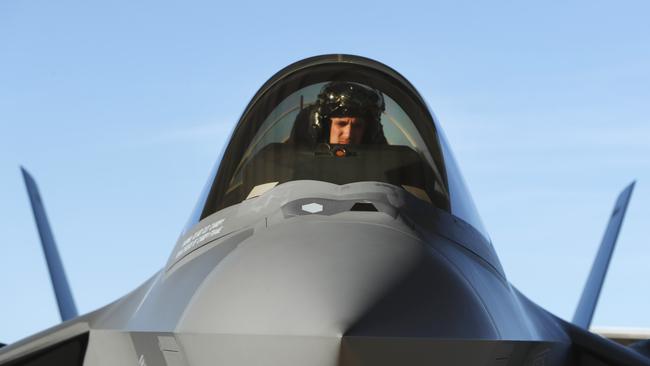The embarrassing problem with America’s best fighter jets
THE United States has two of the most potent and expensive stealth fighter jets in the world, but there’s an embarrassing flaw with them.
THE military might of the US is second to none — but the country’s unparalleled fire power is not without its problems.
At the tip of the spear, the country has two of the world’s most sophisticated, manoeuverable and stealthy fighter jets on the planet. The F-22 Raptor and the F-35 Lightning II are as good as it gets. The former is the Air Force’s fifth generation air superiority stealth fighter and has been described as a “game-changer” in current Middle East operations due to its advances sensors which can survey huge swathes of the battlefield. But the only problem is the aircraft is reportedly rather shy.
The F-22 struggles to communicate with other fighter jets in the US fleet, most importantly the country’s other fifth generation fighter, the F-35. This is a little awkward because for stealth aircraft, information sharing is a key part of the job description.
Modern warbirds. F-22 Raptor and the F-35 Lightning. pic.twitter.com/UCxjY351N3
— My Aviation World. (@Avscene) March 11, 2018
The jets are known as “fifth generation” thanks to their advanced stealth and surveillance capabilities.
Russia and China have also been refining their fifth-generation fighters, the Su-57 and J-31 respectively, while Australia has previously had major issues with its own version of F-35 fighter jets which needed extensive modifications to make them combat ready.
RELATED: Australia’s F-35A fighters may cost millions to bring up to scratch
The communication problem faced by the top US fighters has its origins in the end of the last decade when the US cut short the production of F-22s amid optimistic geopolitical conditions.
The smaller than otherwise fleet means the integration of its communications system is more crucial but because the fighter jet’s systems are designed to go undetected, the added demand it limits the options when building the instruments.
According to Air Force Magazine, which wrote about the communication difficulties this month, both jets have communications gear that’s focused on “low probability of detection or intercept” in order to stay hidden from enemy systems.
But because the F-35’s system was developed 10 years after the F-22’s, technologically-speaking, it took a different approach.
The F-22’s Intra-Flight Data Link (IFDL) is much older than the system used on the newer F-35, leading to the incomparability with certain kinds of communication.
While the F-22’s on board technology can receive much of the data from the F-35 and other allied aircraft, it can’t transmit the reams of useful data it gathers to its counterparts.

When it comes to talking to each other F-22 and F-35 pilots must currently use secure voice links and officials have said the temporary fix has worked in training and simulated combat.
However critics say much needed modifications have been slow coming.
“There’s a lot of improvements that could have been done and should have been done 15 years ago,” David Rockwell, a senior defence electronics analyst in the US told Bloomberg this week.
“The Air Force postponed a lot of things for the F-22,” he added.
According to the report, manufacturer Lockheed Martin and other companies involved in the aircraft technology are working on a solution to the communication issue.



